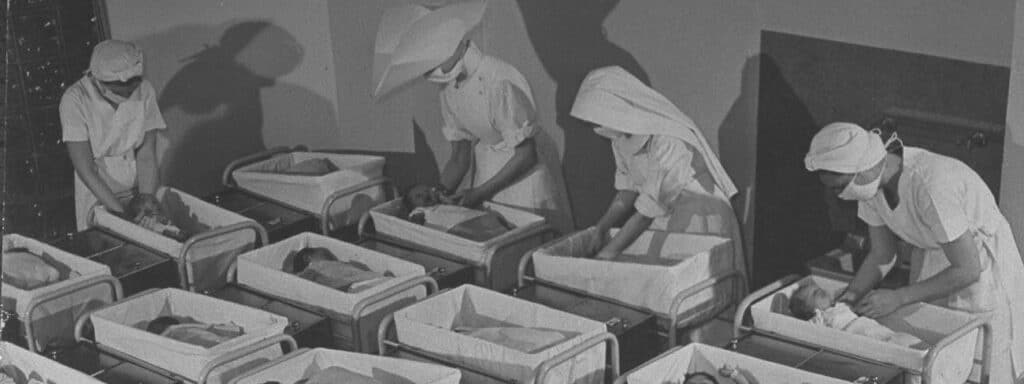Professor Barry Bogin has been a student of human physical growth and development since the 1970s. An anthropologist, and expert on child development, particularly the effects of social, economic and political issues on physical development, he spoke with us after the recent news coverage of his study confirming what we instinctively know: children need love and hope to grow.
In part 1, professor Bogin talked to us about his work in Guatemala, measuring the effects of toxic stress on young Maya children’s development. In the second part of his interview, he discusses the importance of one to one care for children’s development, and his own hopes for an end to orphanage use worldwide
(AW) We often point out that over 100 years of evidence shows orphanages harm children. What did you find when you looked at records spanning over 300 years on children in orphanages, children’s homes and institutions?
(BB) That was actually a study published in the Journal of Physiological Anthropology. I cite the German paediatrician Piper, who did the survey in the 1950s. He showed that, starting in the 1700s, more than 90 to 100% of all the kids in the institutions died.
So in 1955, they knew this.
Even further back, I cite research on every baby under two years of age that went into the New York City Foundling Home. Some were abandoned, some were given up. That was in the 1920s, when these paediatricians (Dr. Chapin, Bakwin, and then in 1945 Dr. Spitz) wrote the most powerful indictment of these kinds of places. Spitz coined the name ‘hospitalism’ for the syndrome that these kids under two years of age suffered.
They were given food, their nappies were changed, but this picture shows the nurses. It looks like it’s COVID times. I mean, the nurses are in full gowns. The only skin showing is a little bit of their forehead and their arms. Their mouths are covered with masks. It wasn’t because the nurses did not care, they were not bad people, but rather they believed that covering up was good for sanitation.
But, they could not engage with the infants. So almost all of them died. That’s because they had really no love. Other photographs from around the same time, staged photographs showing the kids are all in wonderful starched clothing and they have little toys, but there’s only one, severe matron in the picture. That one woman could not provide the love and care that the many orphans needed.

Evidence from Europe
And then there is a very famous study done by a British nutritionist, Professor Elsie Widdowson, who went to orphanages in Germany after World War II, in the British controlled territory. The [science of] nutrition was in its infancy after the war, but there was a lot of interest in it because of all the hunger during and after the war, all the food rationing etc. They had lots of kids in orphanages and they experimented: they gave some kids an extra biscuit, an extra orange, and they gave other kids just the normal fare.
And it turned out after six months, the kids with the extra biscuits and the orange didn’t grow, but the kids who were getting regular orphanage food were actually growing better. Prof Widdowson said “this can’t be right!”. So she switched orphanages. She thought, well, maybe we did something wrong. So she gave the other kids who were growing well, the extra orange and extra biscuits, fortified with various nutrients. And lo and behold, at the end of the six months, again, the ones who were getting the intervention didn’t grow.
Better a meal served with love
But she found out what happened.
The matron, who had been at the orphanage, delivering the intervention in the beginning, had changed orphanages. This matron beat the children. She punished the children at dinner time before they could eat. Well, you know what that does to every kid sitting in the dinner room. There’s no digestion. There’s no absorption. And that’s why the interventions didn’t work.
And she quotes a passage from the Old Testament that “Better is a dinner of vegetables and herbs where love is present than a fattened ox served with hatred.”
So all this stuff has been known. I’m not coming up with something really new, but you’d be surprised how many places have run the story of the press release from Loughborough University. And I was interviewed by a couple of newspapers and BBC, Leicester radio….it’s like people have forgotten.
I forgot. I knew this stuff and I forgot it.
Resetting the clock on severe deprivation
(AW) So how might an orphanage, or any setting where there’s an absence of one-to-one love and care, affect a child’s emotional development as well as their physical development?
(BB) Well, kids who suffer chronic toxic stress have both physical and emotional and cognitive impairments. This is well known. Probably the best examples of this are a British study of British adoptees from the Romanian orphanages during the Ceausescu regime when so many kids were tied in their cots, totally neglected.
The earlier those kids were adopted into families, the better they do, but all of them show residual effects as adults. They have lower cognitive performance, they have physical growth deficiency, they’re small. They’re not stunted, but when you look at them as a group, they’re shorter. And they have various kinds of cognitive impairments.
Of course, these Romanian orphans were not just a bit neglected. They were severely deprived.
So that’s what happens in severe deprivation and with less than severe deprivation, you get less severe impairments. But you get them.
The end of orphanages
(AW) Do you believe from your findings that orphanages should no longer be used globally?
(BB) Absolutely. This is also very well known. In rich countries, the old style orphanages like the New York city facility don’t exist. So kids are placed with families. It is super well known that placing them in the old-style orphanages is bad. So orphanages everywhere in the world should be disbanded.
I have three children. My youngest was in an institution in China. I’m fully aware of how brutal it all is.
China has given up, of course, on these [intercountry] adoptions. They say it’s because they’ve changed their one child only policy. That’s part of it. The other part of it is they realize how brutal the institutional system is. When we got our daughter, she was 14 months old, and she was on the 30th percentile for length. So, she was shorter than 70 percent of kids her age. Now she’s about at the 50th percentile – average height. So she also had her immediate growth spurt after being adopted.
It wasn’t just physical growth, it was development. She wasn’t walking when we got her. She was about three, four months behind. But the Chinese basically put up for adoption girls they knew were going to be healthy. They often put the less healthy girls in the dying rooms at the orphanages. So once the directors of the orphanages sorted the girls out the ones that they didn’t think were worthy were just put into a room with doors closed. They just died of hunger and dehydration.
Fortunately, that’s [no longer] done in China, but I’m sure that it’s still going on elsewhere.
